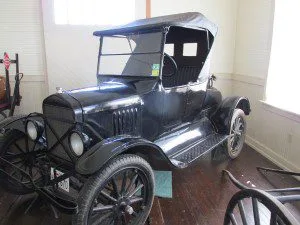As any classic and vintage car collector knows, prior to 1980 there was not such a thing as a formal VIN (Vehicle Identification Number). Going back through time to the first half of the 1920’s and earlier, most Ford Model T’s of which some 15 million were produced between 1908 and 1927, didn’t have a serial number stamped or placed on the vehicle’s body.
 When looking for originality in a Ford Model T, the collector will be searching for an engine number. It wasn’t until the 1926 Ford Model T’s that an identification number was placed on top of the right frame rail.
When looking for originality in a Ford Model T, the collector will be searching for an engine number. It wasn’t until the 1926 Ford Model T’s that an identification number was placed on top of the right frame rail.
These numbers were created in the first place largely for the benefit of the car company as opposed to giving helpful information to the new owner. It was more of a way in which an automaker kept inventory statistics. Where and when the vehicle was built. For the new owner it was used for titling purposes.
Now a century later, car collectors look for an engine number that would be consistent with the vehicle it’s on. That is the proof, or as near as you can get, to knowing whether your Ford Model T engine and body are original. The engine number on a Model T Ford is considered the car’s ID number which today we would say it’s VIN.
Ford Motor Company Statement
Ford Motor Company announced at the time that every one of their engines produced had a serial number on the left hand side of the cylinder block just above the water inlet.
They also stated that if an engine block is replaced, the original stamped serial number should be stamped on the new block. Unfortunately, not every shop that replaced a cylinder block restamped the new one. This serial number was all numerals without letters. The serial number was typically eight or nine numerals long. No commas or other characters were used.
The question arises even after you locate a Model T engine number is whether or not it’s original to that year’s body. Engines were changed out often during the 1920’s. Theoretically you could have a 1923 Ford Model T with a 1925 engine.
Once you locate an engine number, one of the best places to find out more about your Model T identification number is at the Model T Ford Club of America. Their site is www.mtfca.com
How to register an antique car can be a daunting task but not necessarily so. If you run into snags research could be the solution.
trying to register a Ford Model T the question of course is…what is the car’s year? If the engine number points to a specific model year, and the majority of states will typically use engine numbers for registration, then the body should conform to that year also.
Since body serial numbers are essentially non-existent then the physical description of the body should help answer the question. Does the windshield have a slant? Are the wheels wooden or wire? What does the running board look like if the car has one? Items like this may help identify the year but obviously will take a bit of research. Part of this research is to inspect, if possible, a few authenticated models at museums or other collections to compare your vehicle to those. If you can, take photos.
As far as your vehicle is concerned, you’ll want to have photos of the engine number as well as photos of the body. These items will help document your claim to what model year your car or truck is. These will probably be needed by the DMV.
Another thing that you may encounter is how a Model T was originally registered. Some states, California being one, used to register a vehicle in this period by the date of manufacture. Therefore, a 1924 model might have been registered as a 1923. There have also been instances where the DMV mistakenly listed a coupe as a sedan. All of these issues can cause headaches. In these cases it is possible to get titles changed and re-issued. What will be required is documentation, patience and a fee.
If a car or truck has not been licensed for many years you may be asked for a “statement of fact” explaining why it has not.
You may also find that you registered antique vehicle is not required to have annual state inspections. By the same token you’ll usually find that a registered antique vehicle is to be used for display purposes at auto shows and parades or for club activities but not for general transportation.
Above all, your start will be at your DMV office either in person or on the phone to ascertain beyond a doubt what their criteria are to register and date antique automobiles. Some state DMV’s have downloads and/or pamphlets available on requirements for registering antique vehicles.
The websites below covering several states will give you an idea of how each state has different requirements and requests for registering an antique car or truck.
To give you an idea of the procedures involved, website www.thevillagesvintagecarclub.org/how_to_register_your_vintage_car.htm gives you a good idea of what the state of Florida requests.
For registering an antique car in California see website www.onlinedmv.com/registration/california-dmv-antique-vehicle-registration.html
If you want to register an antique vehicle in New York see website www.dmv.com/ny/new-york/custom-vehicle-registration
For Colorado see website www.dmv.com/co/colorado/custom-vehicle-registration
For Ohio see website www.dmv.com/oh/ohio/custom-vehicle-registration
See more of our articles about old car VIN’s and serial numbers on the links below…
Antique and Classic Car VIN’s / What They Tell Us
Locations of VIN’s and Stamps on Vintage Vehicles
(Article and photos copyright 2013 AutoMuseumOnline)


